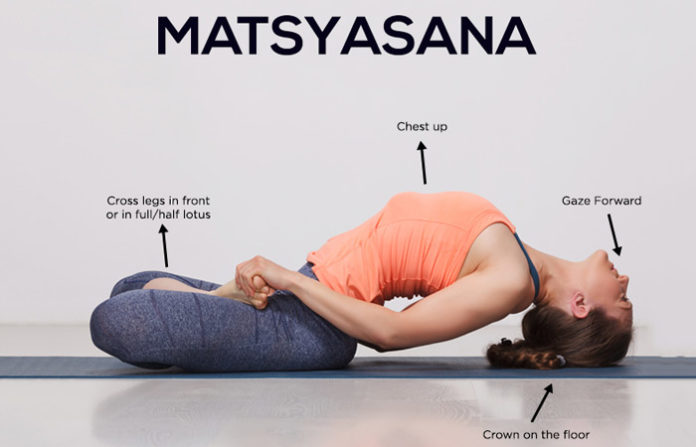By practicing to perform Matsyasana and a hundred Suryanamaskars at one go it’s possible to realize numerous health benefits that could include regulation of digestion, sleep-pattern, metabolism, weight, stress response and an improved skin tone and memory. The author shares her experiments with these two yogic exercises.
By Pragati Oswal
I have personally experimented with many Yogasana (yoga posture) related claims. I shall be sharing two of my experiences, technical findings as well as my mistakes and short-comings.
Matsyasana or the fish posture is given the name because the posture allows the body to float in water. The asana is a backbend, where the practitioner first performs the supine padmasana (lotus posture while lying down on the back) and lifts up the chest rising up on the elbows and drawing the shoulders back. As the arch of the back deepens with practice, and the chest expands with neck and the throat area stretched, the top of the head brushes the ground without any pressure or weight resting upon it.
As soon as I got this posture (matsyasana) right and could hold it comfortably, I really wanted to try performing it in water to test the veracity of its “nominal” claim.My first attempt in water (in a swimming pool) saw me struggle with performing padmasana (lotus posture) in the first place and eventually topple head down into the water. I then moved to the kiddies-pool that had about one and a half feet water. I could sit and perform padmasana with ease. I then started to arch my back, lift my chest so as to rest my elbows in line with the ground, but ended up getting water in my nose. Frustrated, I started to float on my back (like one usually does) and started to observe my body. Concentrated on how my body floated, what made the body float, what my posture was like, what if I changed my posture and what made my body tilt in water if I extended or flexed the spine. And, then, while I was in about 4 feet deep water, floating around, I arched my back with legs outstretched (which is another variation of matsyasana for those who cannot perform the padmasana) and I realized that I could float without having to move my arms or legs. In that moment, while floating on my back, I grabbed each toe one by one locking my legs into padmasana and arching my back and there I was, floating in matsyasana. So, the trick was to arch the back while lifting the chest first to be able to float with out having to move one’s limbs and then go into padmasana. So, the name matsyasana stood the nominal test.
Another experiment that taught me much was with suryanamaskar. Suryanamaskar – a rhythmic series of various yogic postures is regarded as the most complete and holistic form of yoga exercise. It simultaneously works on the over-all stamina and the flexibility of the entire body without knocking the breath out. The known benefits of practicing suryanamaskars include regulation of digestion, menstrual cycle, sleep-pattern, metabolism, weight, stress response and an improved skin tone and memory. Weight loss, fat loss and inch loss however remain the most sought benefits.
Due to all the hype about “size-zero figure – the 100 -Suryanamaskar remedy” and a zillion questions from clients, patients and colleagues, I decided to put the theory to test a while back.
Having been a yoga student, therapist and practitioner for over a decade, I had the pre-requisites – a flexible body, a good stamina and a kind of consistency in my practice of yoga in its various aspects. Also, being well-aware of my nutritional needs, my diet till date usually consists of 1800-1900 calories per day. Being 5ft 5 inches in height, 58 kilos in weight and with a BMI (body mass index) of 21.2 kg/m2, my aim was to come down to 50 kilos so that my BMI would be close to the size zero BMI of 18 kg/m2.
The golden rule of yogic practices is to go about them slowly and steadily. I started with my warm-up, stretching routine and on the first day itself I found it quite easy to do about thirty-six suryanamaskars continuously. By the end of the first month I could maintain the continuity for fifty. By the end of fifty suryanamaskars I would be drenched in sweat but never out of breath. Doing fifty wasn’t really a big deal anyway. During my Masters’ training we used to practice 4-7 sets (12 suryanamaskars = 1set) but not in continuity. We also maintained many yogasanas, each for at least two minutes if not longer.
Anyway, by the end of the second month, I built stamina for sixty-five suryanamaskars at a stretch. After that I found myself pushing harder for every extra-suryanamaskar.I remember the day I hit seventy-five and experienced a peculiar strain in my back. My back strain surfaced time and again. More often than not I would find it hard to persist beyond sixty to sixty-five. I used to practice five days a week on an average. Whenever I took a break for a day or two, I found it easier to do suryanamaskars. By the end of the 3rd month, I had lost 2 kilos but I had also started to feel washed out after my yogasana practice. I took week’s break.
In the meantime, I came across an extra-ordinary yoga practitioner from Poland, who was pursuing PhD in physical education. For the life of me I couldn’t have guessed his age, which was fifty-five by the way.He looked much younger. He told me that he could do 1008 suryanamaskars at a go, in 2 hours 50 minutes. Also, the first time he attempted the maximum number of suryanamaskars, he and his team had noted some pre and post parameters and that he had dropped two kilos (which he believed to be a consequence of sweating profusely) within that time. He demonstrated over 150 suryanamaskars in about 20 minutes before my eyes. Although I found it hard to believe that he could do 1008, but the ease with which he performed 150 or so, was quite incredible.He also told me how, at once, he had been almost obsessive about attaining Padmasana (the lotus pose) and ended up with broken knees and a year of rehabilitation.
As I watched this gentleman go about doing his suryanamaskars, I noticed that he increased his speed post 10thsuryanamaskar or so, he switched to moderate stretching while bending forward and during spinal extensions. I adapted this in my practice and managed 80 suryanamaskars without back-strain. Also, if I practiced sets of suryanamaskars rather than practicing them at a go, I could do 100 without any strain.
By the end of 4th month I remained 56 kilos. I did not lose any additional weight. I think one’s diet has an integral role to play if one wants to attain size zero. Probably one needs to go on a diet lower than 1800 Kcal. Being in one’s ideal weight range (BMI = 18.5 – 24.99 kg/m2), it becomes difficult to shed extra kilos for the “fashionably ideal” size zero target, by suryanamaskars alone. An overweight person can drop kilos and inches faster till a certain point, but to make the transition from medically ideal to fashionably ideal BMI definitely poses a challenge. Also, an overweight person with a background of sedentary lifestyle requires at least 6-8 months of regular yoga practice for significant changes in flexibility, weight and inch-loss.So, I did not become size zero in 4 months. Maybe I needed to persist for longer. Probably I needed to couple suryanamskars with a different diet plan.
It’s been many years since this experiment. I never attempted size zero again, it didn’t fascinate me any longer. Is that called growth or just growing out of something.
Pragati Oswal is a Complementary and Alternative Medicine (CAM) Practitioner and Researcher with expertise in Yoga, Acupressure and Energy Healing. She uses these therapies as a substitute for medicines, to facilitate pain relief, healing and wellness. She can be reached through her website www.pragatioswal.com or her facebook page https://www.facebook.com/PragatiOswal/












